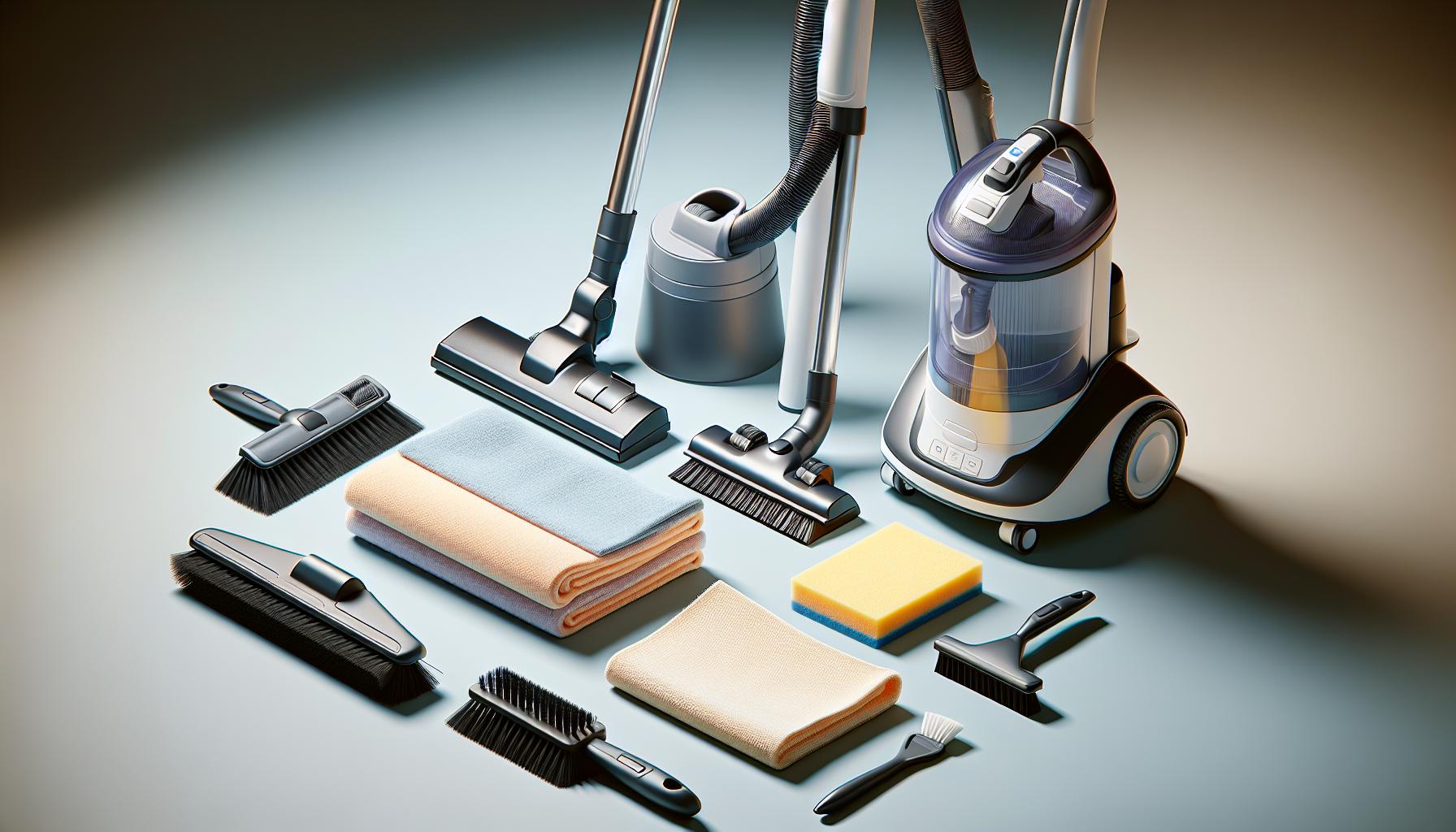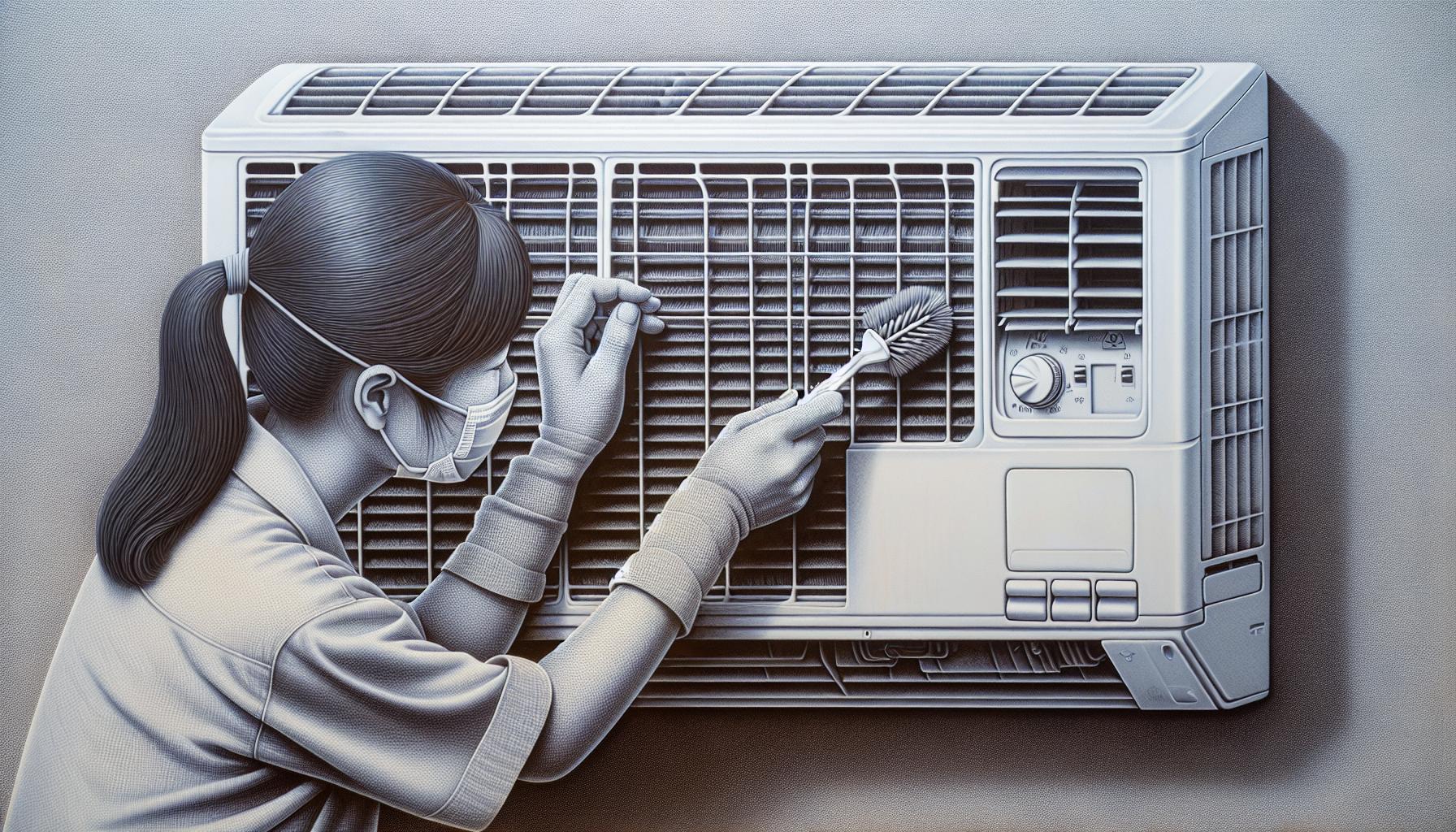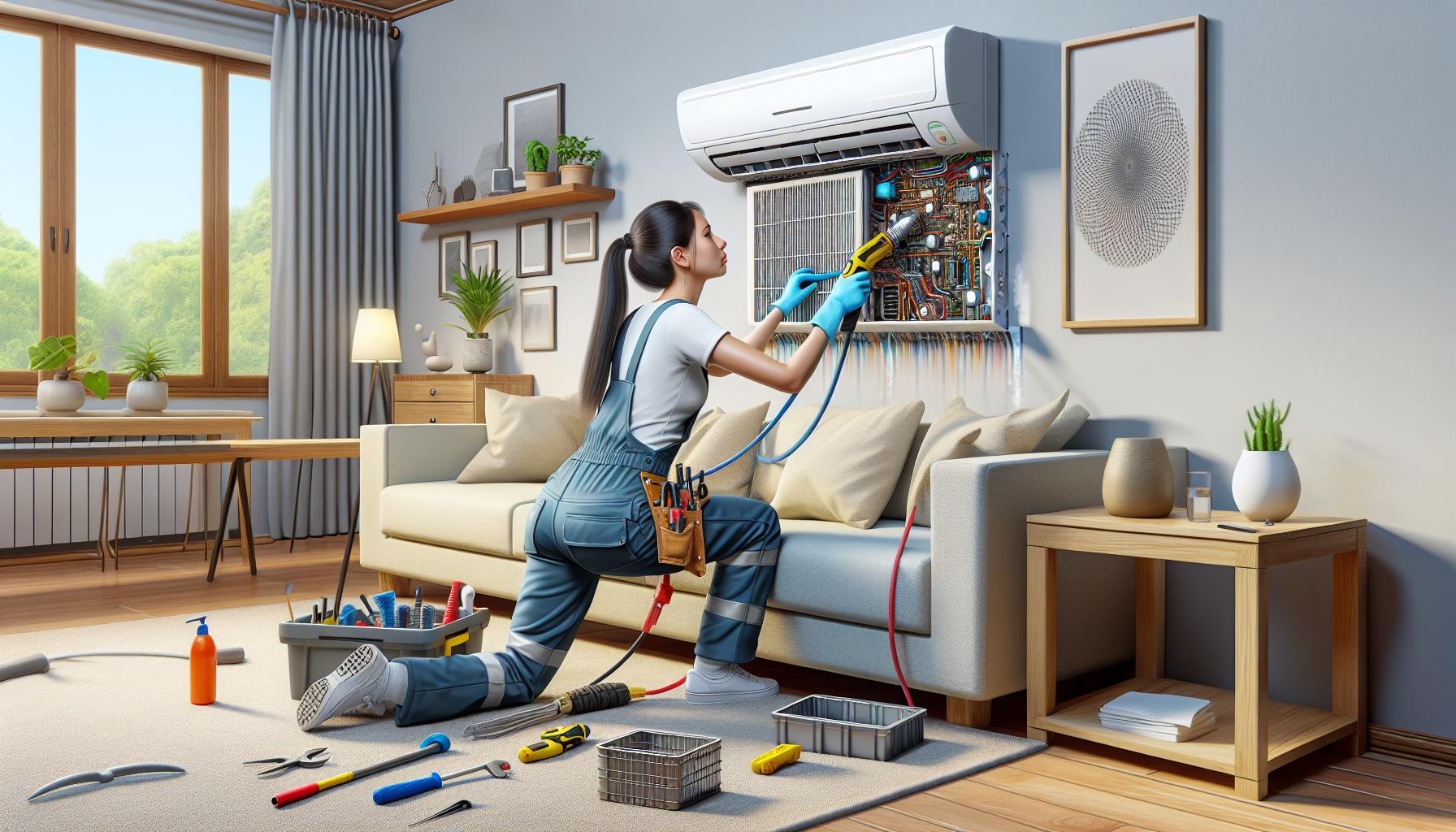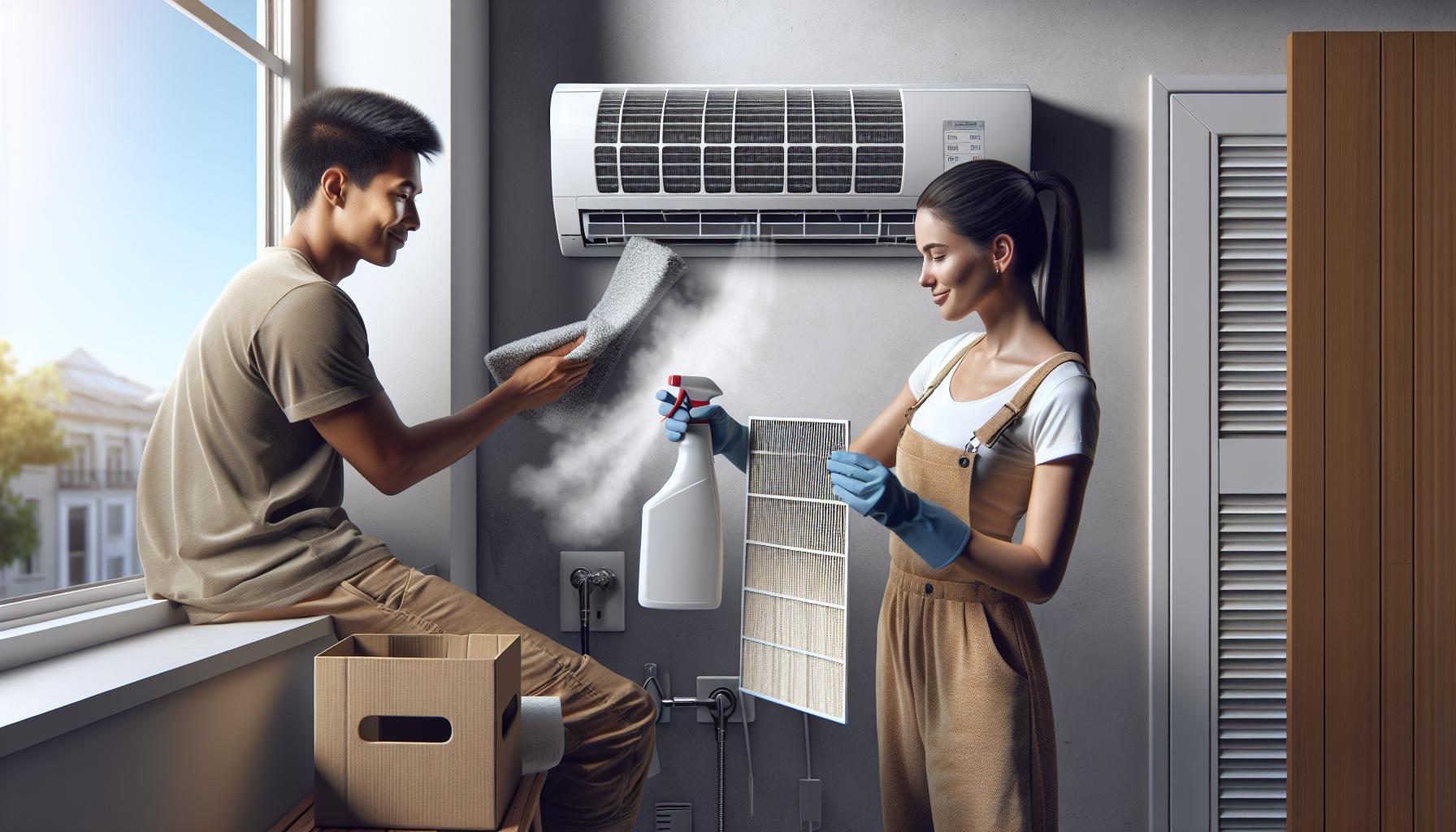Keeping your wall-mounted air conditioner in top-notch condition isn’t just about comfort; it’s about efficiency and air quality too. Dirt and debris can hinder performance, skyrocketing your energy bills and circulating unclean air. You’ll find that a regular spruce-up of your AC unit can prolong its life and keep your space cool and fresh. Whether it’s a mini-split or a through-the-wall unit, a clean air conditioner is key to beating the heat without very costly. Starting with the exterior, we’ll guide you through a thorough cleaning process, ensuring your wall AC unit operates at its peak. Let’s roll up those sleeves and dive right into maintaining your cool oasis.
Importance of Cleaning Air Conditioner Wall Units
Maintaining Good Indoor Air Quality
You’re likely aware that indoor air quality significantly impacts your comfort and health. Cleaning your air conditioner wall units is crucial in maintaining a healthy indoor environment. Unclean air conditioners can circulate dust, pollen, and other allergens that may lead to respiratory problems or exacerbate existing conditions such as asthma. Regular cleaning ensures that your AC is not a source of indoor air pollutants.
- Filters play a pivotal role in trapping airborne particles. When these filters get clogged, the AC s ability to purify the air diminishes.
- Removing moisture accumulated in the AC units prevents mold and mildew growth, which are notorious for causing unpleasant odours and health issues.
- Ensuring that the air blowing through your space is free from contaminants also supports a robust immune system.
Regular cleaning maintains the efficient operation of your AC, guaranteeing that the air in your home remains clean and fresh. ### Preventing Breakdowns and Malfunctions
By keeping your air conditioner wall units clean, you not only improve air quality but also prevent potential breakdowns and malfunctions. When dust and debris accumulate in the unit, they can impede mechanical components and restrict airflow. This could result in:
- Overworking of the AC unit to maintain the desired temperature, leading to increased wear and tear on parts.
- Overheating, which may cause the AC unit to shut down unexpectedly.
- Higher energy bills due to decreased efficiency.
Regular cleaning and maintenance alleviate these concerns, ensuring that every part of the AC operates smoothly and potential issues are spotted before they escalate. This preventive approach helps you avoid costly repairs and inconvenient downtimes. Remember, a well-maintained air conditioner also operates more efficiently, potentially extending its lifespan and providing consistent performance year-round.
Tools and Materials Needed

Understanding what tools and materials are required before beginning the cleaning process ensures a smooth and efficient job. For a successful clean, ensure you’ve got the right kit.
Vacuum Cleaner
Vacuum cleaners, especially those with a brush attachment, are a vital tool in your cleaning arsenal. Your wall AC unit accumulates dust and dirt that can restrict airflow and hinder performance. By using a vacuum cleaner:
- You remove loose dirt effectively before using liquid cleaners.
- It prevents debris from going deeper into the unit which could cause damage.
Regular vacuuming of the exterior fins and internal coils is a key maintenance step.
Soft Bristle Brush
A soft bristle brush is essential for delicate areas of your AC unit. It’s the right choice for:
- Dislodging dirt that’s stuck in the fins and coils without causing any damage.
- Ensuring the sensitive parts of the unit, like the aluminum fins, remain intact.
Remember, gentle strokes work best. If the coils become bent or distorted, this can negatively impact efficiency.
Microfiber Cloth
The microfiber cloth comes into play for wiping away any residual dirt after the primary cleaning with brushes and vacuums. It’s particularly effective because:
- Its fine fibres trap dust particles without scratching surfaces.
- It can be used with mild detergents for a thorough cleanse.
A good tip is to have several cloths on hand one for wet work and another for drying surfaces. Dry the components properly to prevent issues like mold formation.
Step-by-Step Guide to Cleaning

Turn Off the Power
Your first step in cleaning your air conditioner wall unit is to safely turn off the power. This is a critical safety measure to prevent any risk of electrical shock. Locate your unit’s circuit breaker and switch it off, then use the unit’s controls to ensure the power has indeed been shut down. ### Remove the Air Filter
Next, remove the air filter, which is commonly located behind the front panel or in a designated compartment. Open the cover or access panel and gently remove the filter. Remember, this component traps dust and airborne particles, so handle it with care to avoid tearing.
Vacuum the Interior
After the filter is removed, vacuum the interior of the unit using the brush nozzle attachment. This process removes lingering dust and debris that can block airflow and reduce efficiency. Pay close attention to nooks and crannies where dust accumulates.
Clean the Air Filter
Cleaning the air filter involves rinsing it with warm water. For tougher grime, a mild soap or AC coil cleaner is effective. Ensure the filter is thoroughly dry before reinserting it to prevent mold growth.
Clean the Blower Fan
The blower fan needs periodic cleaning for optimal performance. Use a soft-bristle brush to delicately remove any build-up of dirt. Do this gently to avoid bending any fan blades which can lead to imbalances and noisy operation.
Clean the Louvers
Your wall unit’s louvers require regular cleaning to ensure unobstructed air distribution. Wipe them down with a clean, dry cloth, avoiding the use of water or cleaning solutions that could potentially corrode the metal.
Wipe Down the Exterior
Use a damp cloth to wipe the exterior of the unit. Avoid abrasive cleaners which can cause scratches and use gentle circular motions for an even clean. Maintaining a clean exterior not only looks better but also prevents dirt from entering the unit.
Clean the Condenser Coils
Finally, the condenser coils, usually located on the outdoor part of your unit, play a vital role in dissipating heat. Use a coil cleaner and follow the instructions carefully to avoid damaging the fins. Improved heat transfer through clean coils significantly enhances the cooling performance of your unit.
Remember to incorporate these steps into your regular maintenance schedule to keep your air conditioner wall unit functioning efficiently and prolong its lifespan. Regular upkeep is the key to a cool, comfortable, and healthy living environment.
Regular Maintenance Tips

Schedule Regular Cleanings
Proper care and frequent cleanings are critical to ensuring your air conditioner wall unit operates at peak efficiency. Dirt and debris can obstruct airflow and impair the unit’s performance. Professional maintenance is advised at least once a year, ideally before summer peak usage. During a maintenance session, a technician will perform a comprehensive clean-up, including the delicate air conditioner coils, which are essential for efficient heat transfer. Experts are trained not to damage the coil fins during the cleaning process. They’ll also check your system to confirm it’s running smoothly. The frequency of cleaning may vary based on your unit’s usage and the indoor and outdoor environment. Households with high dust levels or multiple occupants might require more frequent servicing.
Change the Air Filter
Your air filter is a first line of defense against dirt and debris entering your air conditioner wall unit. Over time, the filter can become clogged, compromising air quality and system performance. To maintain optimal operation, the air filter should be cleaned monthly during the cooling season.
Here’s a quick guide to cleaning your air filter:
- Remove the front panel of your unit to access the filter.
- Take out the filter and wash it gently using warm water mixed with dish soap or white vinegar.
- Let the filter air dry completely before you reinstall it.
If your unit uses a foam filter and it’s damaged, replace it by cutting an electrostatic filter material to fit. Filters in homes with pets or where occupants have allergies may need more frequent attention.
Keep the Surrounding Area Clean
Clearance around your wall AC unit is an often overlooked aspect of air conditioner maintenance. You must keep a minimum area around the unit free from obstructions. This includes:
- Furniture: Relocate items that might block airflow.
- Plants and Vegetation: Trim any foliage near the outdoor unit to prevent blockages.
- Debris: Remove any rubbish or leaves that may have accumulated.
Ensuring adequate space around your AC unit enhances airflow, reduces strain on the system, and prevents the accumulation of debris that can affect its performance. Regular inspections of the area are as crucial as the maintenance of the unit itself. Monitor the surroundings and keep them clean to promote better air movement and prevent potential damage to the system.
Conclusion
Keeping your air conditioner wall unit in top shape doesn’t have to be a challenging job. By following the steps outlined, you’re ensuring that your system runs efficiently, saving you money and extending the lifespan of your unit. Remember, aside from your own cleaning efforts, it’s essential to enlist a professional’s help annually for that deep maintenance. Stick to a regular cleaning schedule, and don’t forget to replace your air filter monthly during peak usage. Your efforts will pay off in a cooler, more comfortable home and fewer unexpected repairs. Stay cool and breathe easy knowing your air conditioner is well cared for.
Speaking of air quality, you might be interested in Indoor air quality. Additionally, if you’re curious about the mechanics behind your cooling system, check out Air conditioning on Wikipedia. For those interested in learning more about energy efficiency in household appliances, the article on Energy efficiency in transport offers valuable insights. Lastly, don t miss out on understanding the importance of regular maintenance with a read on <a href="https
